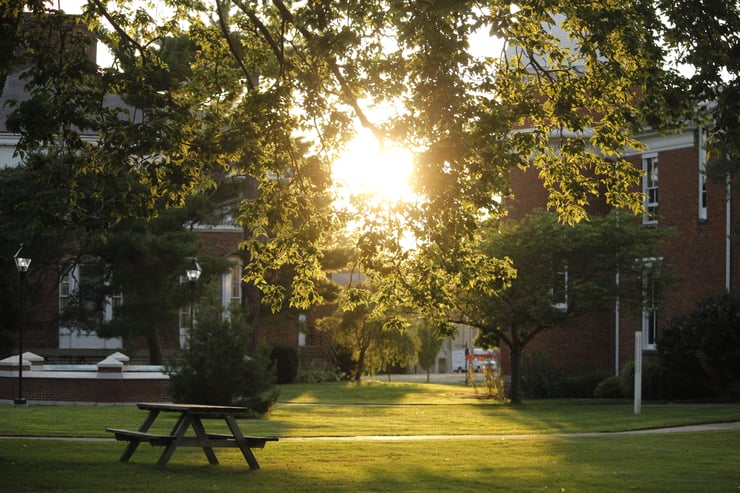SimpsonScarborough announced in January that Jason Simon will join our team this month as vice president and partner. Named AMA Higher Ed Marketer of the year in 2013, Jason is well-known in the higher ed marcomm field, having served as executive director of marketing communications at University of California System since 2009. But you may not know that Jason got his start as a sports writer and editor. We sat down with Jason to learn more about how he got his start in higher ed marcomm, why he is making the leap to SimpsonScarborough and some of the changes and opportunities he sees ahead in our field.
Q: You got your start as a sports writer and editor. How did you get into higher ed marcomm?
A: When I was in college I was a basketball manager for North Carolina State University and really thought I wanted to be a college coach. But I migrated into sports journalism and, later, was the media relations director for NC State’s men’s basketball team for nearly five years. It was a great job—what some might consider a dream job—but I wearied of the lack of control and repetition and was hungry for something else. Fortunately, I had the opportunity to work for a small branding firm in the Research Triangle Park and worked on some great corporate clients—IBM, SonyEricsson, RedHat—helping with brand strategy, advertising and broader communications needs.
After some time there I learned of an opportunity at NC State on the marketing side. It was a newly-created position, the only marketing position, and I was pretty excited about the chance to go back to my alma mater and build a program. We went through a research, positioning, campaign process, and I led efforts to re-launch the main website, launch a capital campaign, and manage a creative service team that was fully funded on charge-back. So my agency experience really came in handy.
At some point, I felt like I’d accomplished almost everything I could have at NC State and had started to keep my eyes out for opportunities when I came across a great position at the University of California System. They had gone through a complete reorganization, so it was a chance to build a team and a program from the ground up. Being at UC has given me a terrific perch to understand issues at multiple campus and system levels and, from a leadership position, to understand the major issues facing higher ed today.
Q: Your keynote at the 2013 AMA Symposium for the Marketing of Higher Education touched upon the need to accept change as a constant—what do you see as the biggest changes coming to higher ed in general, and marcomm in particular?
A: It’s a really exciting time to be a marketer in higher education. There just is so much happening around the broader public dialogue around rising costs of tuition, value of a degree, national policy from the White House, state funding issues, increases in philanthropy, changing (and declining) demographics of college-aged students, the rise of the low-income student, MOOCs, online education and so much more. And between that and the evolution of social media, it’s really putting marketing in such a high-level strategic place at institutions. It’s no wonder the CMO role continues to rise on campus.
I think marketers need to be willing to accept some of these changes, and I believe marketers can be real champions on campus—on-campus consultants, conveners that brings people together—the marketer working with IT, admissions, institutional research, alumni and fundraising. Even at bigger institutions, divides between media and marketing are going away with the opportunity to own your story more directly through social and digital channels. A voice of strategy that can inform campus leaders about changes and perceptions in the market and devise strategies is a real asset to any campus.
Q: The UC logo controversy that blew up in late 2012 seems like a case study on rolling with changes. From the outside, it certainly looked like a controversy that could have been job-jeopardizing. And yet, you were ultimately named AMA Higher Ed Marketer of the Year—tell us more about that.
A: I was fortunate that we had strong leadership support that realized that the steps we’d taken were all sound and solid approaches. It was disappointing but I don’t think I ever worried about my job.
In the midst of the frenzy, I had a couple of conversations with people I really respect in higher ed. There was a real sense of trepidation in what we were enduring, namely because it’s been an all-too-familiar trend not only around logos but really around higher ed marketing efforts in general. Critics were viewing marketing efforts as surface-level promotion. I knew we had to tell the full story—not only to correct things that were left out of the reporting (like the idea we hadn’t done creative testing)—because there was a lot to learn from our experience. I felt obligated to stand up for the importance of marketing and for trying new and different approaches that attempt to cut through the cluttered media landscape we’re all in.
I think one reason our story—and the way we responded and managed through it—has resonated is because there’s a certain inevitability that in today’s social media-driven world, things can flare up and be really visible. Accepting that things don’t always work out and preparing yourself for constant re-adjustment are things today’s marketer must be keenly aware of.











